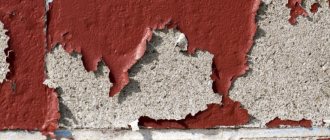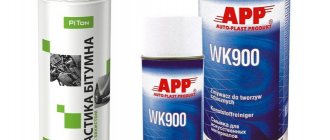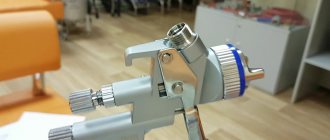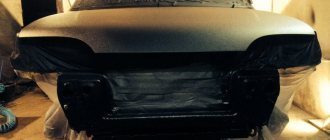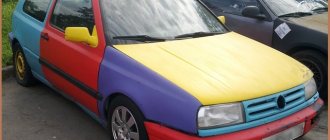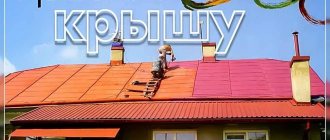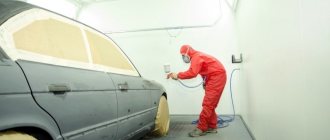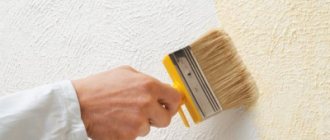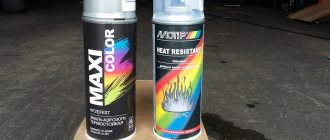Painting a car is a complex and specific task that needs to be done professionally. If the painting process is done incorrectly, after its completion you will have to remove a lot of unpleasant little things. This will delay the work and make the appearance of the machine of lesser quality. Lumps of paint, unpleasant streaks and drops, dots and an uneven layer - all this happens when you approach the car inappropriately or in the wrong conditions. Shagreen when painting a car sometimes occurs even among specialists with extensive experience.
Shagreen is an “orange peel” that can be very noticeable or quite fine. If painting is done by a specialist in a chamber, then this effect will not be noticeable. If you use high-quality materials and good equipment, you can completely avoid such a nuisance. Such effects can be removed either by redoing the work in a certain area or without painting. Shagreen leather should not be allowed to appear on a beautiful car. Let's take a closer look at this point.
How to eliminate shagreen
When shagreen appears after painting a car, owners naturally have a question: how to remove it? There are only 2 methods: polishing and repainting, and which one to choose will depend on the degree of damage to the paintwork.
Surface polishing
When the shagreen is not pronounced and does not affect the primer, you can try to smooth the surface of the car by sanding. For this purpose, special abrasive pastes and attachments are used, and the degree of their hardness should become less and less as polishing progresses, and at the final stage the machine is simply given a mirror shine.
In some cases, polishing will have to be done only on some parts of the machine; it’s worse if you have to process the entire body.
https://youtube.com/watch?v=8R4wNkEZ7U
Repainting
If polishing the surface does not give the desired result and the paint still looks uneven, then the only option left is to repaint the car. To do this, remove the varnish and color from the car down to the primer. If the base layer is uneven and lumpy, then it is cleaned down to the metal, and the priming and painting procedure is repeated again.
When repainting, it is important to carefully remove traces of previous compounds from the body, otherwise there is a high risk of a conflict of chemical elements, as a result of which bumps and sagging may appear again. Car repainting should be trusted only to specialists with extensive experience in order to minimize the risk that the problem will arise again
As a rule, with a high-quality application of primer and then paint, their thorough polishing after complete drying, the car looks like new and nothing reminds you that the first painting was unsuccessful
Repainting a car should be trusted only to specialists with extensive experience in order to minimize the risk that the problem will arise again. As a rule, with a high-quality application of primer and then paint, and their thorough polishing after complete drying, the car looks like new and nothing reminds you that the first paint job was unsuccessful.
X
Shagreen after painting a car - how to deal with the problem?
Painting a car is a complex and specific task that needs to be done professionally. If the painting process is done incorrectly, after its completion you will have to remove a lot of unpleasant little things. This will delay the work and make the appearance of the machine of lesser quality. Lumps of paint, unpleasant streaks and drops, dots and an uneven layer - all this happens when you approach the car inappropriately or in the wrong conditions. Shagreen when painting a car sometimes occurs even among specialists with extensive experience.
Shagreen is an “orange peel” that can be very noticeable or quite fine. If painting is done by a specialist in a chamber, then this effect will not be noticeable. If you use high-quality materials and good equipment, you can completely avoid such a nuisance. Such effects can be removed either by redoing the work in a certain area or without painting. Shagreen leather should not be allowed to appear on a beautiful car. Let's take a closer look at this point.
Removing shagreen
polishing a car with your own hands after painting if shagreen appears
Small defects in the car's varnish appear even in close to ideal working conditions. Simple roughness can be removed by regular polishing. To get started, you need a bucket of warm, clean water (ideally distilled, without detergents, dirt, etc.) and sandpaper from P1200 (with gentle pressure) or P1500. Final polishing is carried out with numbers P2000, P2500. Final work - polishing pastes 74, 75, or ZM pastes (pure abrasive and transition). The basis for sandpaper is hard rubber (in extreme cases, a block).
For perfect polishing you will need not two, but three abrasive pastes. You need to start using them after slightly matting the surface with sandpaper (P1500, P2000). When working with paper, be sure to use water; excess H2O is removed with rubber. Car polishing is simplified by a machine with variable speed control. Uniformity of movement is important: you cannot linger in one place, otherwise stripes and transitions will appear.
Special abrasives are produced specifically for removing shagreen, such as Trizact wheels. These are abrasives with P2000 and P3000 grit on a soft backing. If you have a lot of experience working with sandpaper, you can use a harder abrasive (up to P1000), but you will have to work hard to remove the marks from its work. If the aesthetic properties of the varnish on a car are not improved even by such abrasives, most likely removing the paintwork and repainting the car cannot be avoided.
Paint, unlike varnish, requires harsher abrasives, but not because of the hardness of the material. The shagreen marks formed on the paint must be removed before applying the varnish, but matting P1500 and P2000 cannot provide the required degree of adhesion - the varnish will begin to peel off even from a slight blow to the car
The necessary adhesion is achieved only when sanding with P1200 grit and coarser, but such materials must be worked with extreme caution
Removing minor defects in 3M varnish
Shagreen. How to get the finish you want
How to avoid shagreen when painting
How to remove shagreen
What to do if you still painted a car with ugly shagreen and it needs to be removed. It all depends on how big the shagreen is. In many cases, it is easier to repaint a part rather than correct a defect.
If the shagreen is small and you need to correct it quite a bit, Trizact 3000 from 3M will help here. Treat the surface using an eccentric machine while it is wet. It practically does not “cut” the material and is ideal for correcting small shagreen. Since Trizact is soft-based, it will not completely smooth out the shagreen, but will make it a little less noticeable. After this, the surface is very easily polished and there are no sanding marks left.
If you still mess up and the shagreen is very high and pronounced, then you can’t do without sanding. To do this, you will need abrasive paper P1500 P2000 or P2500 It all depends on how “sad everything” is for you. I recommend paper from 3M. For convenience, a sanding “squeegee” from Mirka is used. Sand the wet surface using smooth “back to front” movements; to control the surface being treated, wipe it dry. After sanding by hand, use Trizact 3000 to remove the directional mark and you can polish.
Sometimes it is necessary to completely remove shagreen. This surface is called “bald”. Shagreen is completely removed by manual wet sanding. First, an abrasive with a grain of P1200 is taken, then P1500. Be careful, you can easily wipe down to primer, paint or even metal. Dry the surface to see the result of the work. Small glossy depressions will be unpolished shagreen. You can also use dry sanding using a sanding machine.
Reasons for the appearance of shagreen
Car painting tool
Cynics call shagreen “automobile cellulite,” connoisseurs of romantic comparisons call it “orange peel.” The appearance of the defect fully corresponds to these definitions: the covering ability of the material does not suffer (as well as strength), but the appearance deteriorates beyond recognition. Small bumps form where drops of paint fell to the surface already dried, or where their drying process was noticeably different from the substance surrounding them.
Painting without shagreen skin means knowing the main factors of its formation and systematically preventing them. This can happen for several reasons, but the atmosphere factor influences paint drying more than others. The correct temperature and humidity can easily minimize the risk of defects forming on the surface of the car.
How to paint without shagreen
How much does a VAZ 21.0.1 car weigh? how much does a car weigh? vehicle specifications
As you saw above, for painting without shagreen, you need to pay attention to many aspects. But the most important thing is experience
Even under ideal conditions, it will be practically impossible for a beginner to apply the necessary shagreen, as close as possible to the factory one. And so let's look in order at everything that will prevent us from painting without the effect of pronounced shagreen skin.
1. It’s probably worth starting with the most basic problem of shagreen, which is the lack of working pressure during painting. The reason for this is a weak compressor, insufficient air supply in the receiver, incorrect air hose, small diameter of the holes of the quick-release connections. Due to lack of pressure, the paint or varnish does not break down enough and flies out onto the part being painted in large drops. The optimal pressure at the outlet (that is, when the trigger is pulled) of the gun (low pressure) should be 2-2.5 atmospheres. From experience I can say that this is the most common problem.
2. The next working tool is a paint sprayer. Almost all novice painters use cheap Chinese spray guns to begin with. In principle, an experienced painter will be able to paint decently with a Chinese gun, but for a beginner it will be a real torment. Very often, cheap sprayers have a crooked spray pattern and poor quality spray. If there is an opportunity and you are going to work in the future, then buying a good, expensive spray gun should be your first priority.
Also pay attention to the nozzle size. Ideal size for applying paint and adjusting the required pitch 1.3 and 1.4 mm
You will not be able to paint with a 1.8 nozzle primer gun without shagreen.
3. The next reason for unsightly shagreen when painting a car is improper use of the spray gun. The distance to the part to be painted is calculated incorrectly. The paint flow is incorrect. It’s difficult to describe in words how to paint; everything comes with experience and for certain situations, settings, and the application method can change dramatically. Let’s say the paint feed is very open, then the gun should be driven a little faster and a little further from the surface, and vice versa, if the feed is screwed down, then the speed is lower and the distance to the surface is closer. Once again, this is all purely individual to the type of repair, materials used, tools, etc.
4. The viscosity of the material plays a very important role here. Incorrectly diluted paint or varnish greatly affects the formation of the desired shagreen. Dilute in the required proportions and use the thinner at a certain ambient temperature.
5. It is worth noting that there is a concept called “shagreen on the base”. This means that with two-layer painting, when the varnish is applied to the base, it repeats the structure of the base paint. That is, if your base is “crooked”, heavily sprayed or very greasy, then the shagreen of the varnish will repeat the texture of the base. Therefore, the base paint must lie “smoothly” so that the varnish spreads as it should!
A small note or advice: If the factory part is matted with Scotch Brite, without using an abrasive, then the factory shagreen is preserved and the new applied varnish will repeat it in part. Here, of course, experience and work skills are important.
Reducing shagreen with polishing
How to set up a spray gun for painting a car
Shagreen is a paint texture that resembles an orange peel. It is formed due to the viscosity of the varnish, which is applied in small droplets sprayed with a spray bottle. These droplets create a bumpy texture on the surface of the body, but gradually, spreading, it smoothes out.
Car varnish or paint hardens quickly. At the same time, their viscosity increases every minute. The drops do not have time to completely spread, turning the surface into an ideal “water” surface. Often they freeze without reaching an equilibrium state.
Too noticeable shagreen is a disadvantage. You need to get rid of it, otherwise the car will not look perfect, especially upon closer inspection. And there is only one way to do this - abrasive polishing.
During the polishing process, the abrasive removes the tubercles that form shagreen. There is no need to be afraid to do this, because the thickness of the varnish is determined by the lowest point of the layer, and not the highest. Essentially, shagreen is removed by grinding, and only then the leveled and matted surface is polished.
When sanding, shagreens are guided by the pattern. If the surface being treated remains spotty (matte spots interspersed with glossy ones), then sanding should be continued. As soon as the spotting goes away, you can proceed directly to polishing with pastes.
The choice of polishing paste manufacturer depends on the personal preferences of the car painter. In other words, who is used to what! Some prefer 3M, others prefer Farecla, others prefer lesser-known products. The main thing is that the result is satisfactory.
After polishing the painted car, the shagreen should disappear. To check the “orange” without leaving the garage, you need to look at the reflection of the lamps. Their boundaries should not be torn.
Removing the “orange peel” with high-quality painting
Even many experts with extensive experience sometimes wonder how to remove shagreen after painting a car. This is a rather difficult task, which is performed individually in each individual case. To get rid of troubles on the surface of metal parts, from various bumps and pits, you will have to perform the following procedures:
- Wash the paint down to the primer, leaving no old enamel on the damaged area.
- Assess the quality of the soil and, if necessary, wash it down to metal.
- Perform metal processing to eliminate unpleasant effects in the future.
- Open up the area with a new layer of primer and wash the top part again for a smooth surface.
- After the primer has dried, paint the area using high-quality enamel.
Also, after completing all the processes, it is necessary to thoroughly polish the paintwork, making sure that there are no unpleasant effects. The car will look great if all processes are carried out efficiently. But in the case of local painting, other problems are possible. If the transition to the old coating is not done professionally, you will have to deal with a visible spot of local paint. So this task is also performed only by specialists.
Polishing and hardness of paintwork
The paints and varnishes used to cover a car can have different hardnesses. Acrylic enamels themselves are quite soft, so they can be easily polished. They already contain varnish, thanks to which they retain their shine after drying.
In turn, car varnishes can be both soft and very hard. Usually, their own cars are coated with, if not the hardest varnishes, then something close to it. They wear less, which means they don't need to be polished as often. At the same time, polishing such coatings lasts several times longer.
Ceramic varnishes are considered the hardest. In addition, they know how to self-heal. There are fewer scratches on them, and those that exist “overgrow” over time. But polishing ceramics is very difficult, which means making a transition.
The best option is MS varnish, which contains a large dry residue and is highly polished. UHS varnishes are also good, but they dry too quickly, which is why they do not have time to spread in a warm room and form a pronounced shagreen.
Thick varnishes are applied in one and a half layers, and this is enough. And HS needs to be applied in 3-4 layers, but it costs less. In general, the cost of a varnish coating with the same thickness is approximately the same.
Interesting video: machine polishing of the hood after painting
- Five rules for polishing car paint
- The feasibility of polishing car paintwork
- Theory and practice of protective polishing of a car body
Alternative methods of applying paint to a car body
Powder painting of cars will help to avoid the possibility of unevenness and cosmetic defects as much as possible. This technology makes it possible to obtain high-quality polymer coatings with minimal material consumption and good performance properties. And special additives that regulate spreading and have good corrosion resistance provide reliable protection to the body metal.
The powder paint method has a number of undeniable advantages, which has led to the popularity of its use in the modern automotive industry.
Forget about fines from cameras! An absolutely legal new product - NANOFILM, which hides your license plates from IR cameras (which are installed in all cities). Read more about this at the link.
- Absolutely legal (Article 12.2.4).
- Hides from photo and video recording.
- Installs independently in 2 minutes.
- Invisible to the human eye, does not deteriorate due to weather.
- 2 year warranty
The role of paint and varnish material in painting
Modern paints must be of high quality, only then will it be possible to adhere to the required high painting technology.
Today's paint and varnish materials are truly reliable and at the same time relatively low in cost. What is car paint characterized by? First of all, it must contain pigment substances, binding elements and a solvent, each with its own functions. The coloring itself is a complex technological process that requires constant monitoring.
For example, paint and varnish material loses its elasticity when the solvent evaporates and becomes very thick.
Everyone is familiar with the metallic color, which requires special enamel with the addition of aluminum powder. Thanks to its particles, light rays are reflected, creating that very shiny surface of the car.
But here, too, to achieve the desired effect, you must strictly adhere to the required painting technology, because paint can both decorate and protect a car if applied properly, or, conversely, ruin the appearance and promote corrosion.
Preparing for painting
Many problems when painting a car arise due to improper preliminary preparation of body panels. This is a very important stage that must be taken very seriously. Basic points include matting, washing, drying, and degreasing.
It is important that the surface to be painted is dry and without the slightest hint of condensation. It is necessary that the temperature in the room where the car is painted is from +10 to +25 degrees Celsius. You need to use the right proportions of paint components and set up the spray gun correctly. You can read more about preparing your car for painting in another article.
Painting technology without shagreen
The paint drying mechanism is based on the evaporation of the solvent. The solvent dries, the enamel remains. The main difference between solvents is the drying speed, but the evaporation rate is also affected by temperature, humidity and air saturation with solvent vapor. All of these are interconnected parameters; the process can be adjusted by changing the temperature, paint application technology, or diluting the enamel to the desired degree. It seems that it is easier to change the viscosity of the substance, but too liquid paint will lead to smudges on the surface of the car, dry paint can worsen the shagreen. Thus, a defect may appear for the following reasons:
- The paint is prepared (diluted) incorrectly - it is recommended to use the manufacturer’s data, and to increase accuracy, use measuring vessels.
- The required proportions are used, but the solvent is not native (too fast, too slow) - when choosing a solvent, you need to take into account the paint manufacturer’s data, the volume of the room and the quality of ventilation (the data on the solvent packaging is only correct if there is good ventilation).
- High temperature - the temperature in the room reserved for painting the car should not differ much from room temperature (20-23˚C), otherwise you will have to make allowances for this: dilute the paint more, change the way you work with the spray gun (movements, distance to the surface) .
- Uneven compressor operation and air spitting lead to uneven distribution of enamel and the formation of shagreen.
- Wide hole in the spray gun nozzle.
- A large distance to the surface - a certain percentage of the paint may begin to dry in the air if the distance is large; the effect is especially pronounced at high temperatures.
As mentioned above, temperature, ventilation, percentage of solvent and its quality characteristics are interdependent parameters. When faced with this problem for the first time, it is quite difficult to determine the cause, due to the fact that not one parameter changes at once, but several. If an attempt is made to change the viscosity of the paint to eliminate shagreen, then the temperature cannot be adjusted under any circumstances, otherwise the reason will remain unclear if the result is unsuccessful. Painting parameters need to be changed gradually, step by step.
Experienced craftsmen determine the viscosity of enamel by eye. If the temperature is high, then the paint on the car should be thinner. In difficult conditions, the spreadability of the substance is assessed on a test sample: a piece of paper is glued to the wall, and several layers of paint are applied on top. Layers are applied until leakage begins.
Reasons for the formation of shagreen
Beginner painters very often encounter the problem of shagreen paint after painting a car. Of course, adherence to technology and a responsible approach to work will help minimize the possibility of defects. But in order to completely get rid of shagreen, you will also need ideal atmospheric conditions with a certain level of humidity and temperature. Among the main factors that contribute to the emergence of such shortcomings are the following:
- Incorrect adjustment of the spray gun. If the gun nozzle is not at the optimal distance, then this location often leads to paint splashing. Therefore, it is important to select the correct diameter of the spray hole of the device and pre-adjust the air stream.
- Inconsistency of the microclimate in the box. To ensure uniform drying of paint and varnish products, it is necessary to adhere to the temperature regime. So, if the hangar is too hot, this can lead to increased evaporation of the solvent and premature hardening of the paint. Otherwise, it will dry very slowly, forming clumps.
- Uneven operation of the compressor. The consequence of the air “spitting” of this electrical apparatus is the uneven distribution of enamel and the formation of shagreen.
- Chemical incompatibility of the solvent with varnish or primer. The issue of choosing a solvent that matches the primer and varnish is extremely relevant. And if this factor is neglected, all the work can go down the drain.
- Insufficient paint viscosity. This problem can occur if the technology for preparing its composition has been violated, or the wrong container has been selected for measuring the dosage of components. Painting a car is a very serious undertaking, and here you cannot add hardener and thinner “by eye” without adhering to the proportions.
- Storing the coloring composition in a cool place.
The final result depends on the quality of the work at each stage. Priming, enameling, varnishing of the car body - all this must be performed at the highest level. Even a minor mistake in one of the steps can lead to a defect appearing after painting and drying is completed.
What to do to prevent a defect from appearing
It is possible to paint a car without the appearance of defects, but to do this you will need to follow some rules and adhere to painting technologies.
Many masters highlight the basic requirements that help prevent the appearance of shagreen:
- At the moment when the paint and varnish composition is mixed, the proportions should be strictly adhered to. In order for the proportion to be maintained with greater accuracy, it is necessary to use measuring containers for work.
- A solvent should be used to paint the car and mix the paint. It must match the paint; as a rule, the manufacturer writes on the can which solvent should be used. You also need to know that the solvent is used not only according to the manufacturer’s recommendation, but also depending on the climate, room ventilation and volume of work.
- Also, before painting, you should properly set up the spray gun. It should have a passport with data on pressure and other characteristics. Tool adjustments must be made after any use.
- The temperature in the room must correspond to certain indicators, namely about 20 degrees. A temperature discrepancy of 1 degree is allowed, both up and down.
- Storage of paint and varnish compositions should not be in a humid place, and the temperature should correspond to the data in the paragraph above
It should be noted that shagreen is not so easy to remove from a car. In this regard, you need to be well prepared, since you will need to spend a little money and time.
Compatibility of solvent and paint
Shagreen can form at any stage of painting: primer, enamel, varnish. At the same time, the final result is equally influenced by errors at all previous stages (the so-called memory effect). It is not always possible to track a defect visually, since it can form under the next layer due to insufficient (incorrect) intermediate drying. In rare cases, the solvent and primer may be incompatible with each other - the issue of choosing a solvent for a varnish coating is an order of magnitude more pressing.
Varnish thinning must be carried out in strict accordance with the manufacturer's instructions. The instructions usually indicate a specific solvent; in the absence of such data, it is best to use products from the same company
In the absence of data, you can use solvent 650 with caution, starting with a ratio of 2:1 (maximum 3:1). The miser pays twice. A good gun costs a painter about 2-4 thousand
rubles, but this money is earned by evenly applying paint. Shagreen often forms at the site of spitting, due to the fact that the paint clots at this point on the car differ in density and drying pattern.
The air supply must comply with the requirements of the sprayer, and the nozzle adjustment must comply with the data specified by the paint manufacturer. The spray gun is adjusted after each application, since the diameter of the nozzle may change slightly over time. Setting rules are indicated in the instructions for the spray gun.
Why does shagreen occur?
There can be many reasons for the appearance of unwanted car shagreen. The most common include:
1) poor quality paint, which may not be sufficiently liquid or viscous. In order to prevent the occurrence of shagreen, you need to buy products only from trusted, well-known manufacturers and under no circumstances purchase paint from dubious stores. You also need to strictly follow the paint thinning procedure in accordance with the manufacturer’s recommendations and the rules for choosing a solvent, which depends on the temperature in the work box, humidity and other factors. To first ensure the proper quality of the paint, it is best to try the paint on a test area before starting painting work.
2) Poor surface preparation before applying paint (for example, poor cleaning of the old coating), as well as incompatibility of the main components of the coating - primer, paint and varnish
3) improper storage of paint or putty is most often associated with a violation of the temperature regime), as well as too low or high temperature and insufficient humidity in the paint box.
4) low-quality equipment manufactured by defectors or dubious manufacturers. Don’t be tempted by the cheapness of the paint sprayer, which can cost you too much, buy products from factories with a high reputation!
5) insufficient working pressure during painting, which can have many reasons - from insufficient compressor power to an incorrectly selected air hose
6) spray gun clogged
7) the ineptitude of the master himself, who does not cope with the rules of painting, for example, holds the spray gun too far or too close.
 failure to comply with the paint application period, non-compliance with the drying technology of a multi-layer coating that does not have time to harden
failure to comply with the paint application period, non-compliance with the drying technology of a multi-layer coating that does not have time to harden
How to get into shagreen
Newbie 06/19/2017 Painting
5291
If we look closely at the painted surface, we will see that it is not completely smooth. There is always a more or less clearly expressed “shagreen” on it - barely noticeable bumps and depressions, reminiscent of the skin of an orange.
Shagreen is characteristic of absolutely any spray-painted surface. Even on those coatings that are applied at the factory, shagreen is always present - this is due to physical processes during the drying of the varnish. When sprayed, the paint falls on the surface to be painted in the form of drops, and before they harden, they do not have time to completely spread and form an absolutely smooth surface without texture.
Therefore, when repainting it is impossible (and not necessary) to avoid shagreen.
It is important to “get into shagreen.” That is, the painted part should have approximately the same shagreen color as the original one, and deviations in one direction or another are not welcome
Shagreen is influenced by many factors. Like the recipe for preparing paintwork materials, using faster or slower thinners (the slower the thinner, the more time it takes to spread and the smoother the shagreen, and vice versa), so are the settings of the paint gun and the application technique. The type of gun also affects shagreen. HVLP guns produce larger shagreen grains than LVLP guns, since the low pressure at the outlet of such guns is not able to break varnish or paint (especially materials with a low solvent content) into small droplets.
Most often, the ways to “adjust” shagreen are as follows:
- increased or decreased atomizing air pressure;
- changing the application distance;
- changing the speed of passage.
For example, if we take a varnish of standard viscosity and apply it at standard pressure (2 atm) and at a standard speed, we will get, relatively speaking, “average” shagreen. If, with a varnish of the same viscosity, we slightly reduce the pressure and reduce the speed of passage, we will get a smoother and more wavy shagreen. By slightly increasing the pressure and speed of passage, the shagreen will be finer, more frequent and sharper.
In this way, by varying the above parameters and using your precious experience, you can imitate the factory shagreen of absolutely all famous cars: from a large wave of Mercedes SUVs to small, almost imperceptible ripples of sports Toyotas; from a very smooth wave of American Cadillacs, to a more pronounced shagreen, characteristic of Russian cars.
If the shagreen is very large, it can always be reduced by polishing. It should be borne in mind that cutting off shagreen with harsh abrasive treatment will lead to the formation of an unnaturally “bald” mirror surface of the varnish. Only a gentle impact will eliminate shagreen, while maintaining the surface structure identical to the undamaged areas.
How to prevent shagreen
Many people try to paint without shagreen, since a regular smooth surface always looks attractive. If for walls, heating radiators, surfaces with visible joints, the shagreen effect is acceptable and even a priority, then when painting a car this is unacceptable.
Shagreen is almost always present, the only question is its visibility with the naked eye.
To avoid this effect, you should use only high-quality paints and varnishes, a serviceable, correctly configured painting tool. When purchasing paint, primer, varnish, in a store, you can ask the seller for a certificate of conformity for the product to ensure that paint and varnish materials are produced in accordance with GOST. This will confirm the quality of the product at the level of the manufacturer and the companies that control its quality.
If you are not confident in carrying out high-quality work without defects after painting, you can do it on a so-called sampler. Take a small area of the surface and paint it. If no problems arise, continue painting.
Roughness can be prevented if the following requirements are met.
- Carry out painting under the correct temperature conditions (+18-24°C), this will allow the paint and varnish material to preserve its properties and consistency, which is important for proper spraying through the spray gun.
- Correctly set up and operate the spray gun - with constant pressure and the correct distance from the surface to be painted.
- The temperature of the metal and the environment inside the box must match; paint on metal that is too cold or too hot will not adhere properly.
- It is better to carry out work inside a special spray booth; all conditions for tightness and temperature will be met.
- The quality of coloring will largely depend on the thickness of the dye, so it must be properly diluted with a solvent. It is better to find out the correct proportions and possible dilution method in the instructions for use for paintwork materials.
Elimination of defects
As practice shows, shagreen is often obtained after painting a car. This is due to the fact that it is not possible to follow all the rules when performing the operation. To correct the situation, you have to resort to some methods:
- Polishing.
- Repainting.
Then the shagreen will need to be removed using sandpaper. To work, you need water and the abrasive itself with a grit size of P1200 and P1500. When the main defect has been removed, you need to finish the polishing stage with P2000 and P2500 paper. After cleaning, you need to go over the parts with polishing paste to smooth the surface and give it shine.
It is worth noting that when repainting, you need to remove all fresh paint and use sandpaper to smooth out and remove defects. After this, you can begin repainting.
Reasons for appearance
Shagreen on a car can result from improper painting. And it arises for the following reasons:
- The paint and varnish product was prepared according to the wrong recipe. As a result, the consistency turned out to be of low viscosity, which was not enough for uniform application on the surface of the car.
- The paint manufacturer's instructions were not followed correctly. The wrong solvent may have been used.
- The spray gun has not been adjusted correctly, so the air pressure does not meet the required parameters.
- The spray gun used a very large nozzle. here is the Hydra mirror
- The conditions in the box where the car was painted were unfavorable. The air temperature is either higher or lower than normal, which is why shagreen appears when painting and other defects.
- The car paint product was stored incorrectly (at low temperatures). When using such paint, it lies unevenly on the surface of the car.
- The painted parts were not dried correctly and the drying times of the layers were not maintained.
Shagreen on a car can appear even if the car is painted in specialized services. In order to avoid its occurrence, it is necessary to take measures that prevent such a defect.
Causes
The main reasons for the formation of unforced shagreen:
- weak or insufficient quality of paint coating (enamel, varnish, primer);
- malfunctions or incorrect configuration of painting equipment (paint gun);
- presence of defects on the treated surface;
- lack of proper conditions for performing work;
- painting at too far or close distance from the surface.
If the paint and varnish product is of poor quality, it may have a heterogeneous structure with various impurities, and during exit from the spraying device it may quickly curl up. Such dried particles form unevenness on the surface, and in large quantities they create the shagreen effect.
The problem of incompatibility of paintwork materials with each other is acute. When painting and preparing the base, it is better to use materials on the same base, ideally from the same manufacturer.
What is shagreen
Often car owners, when painting a car or part of its body with their own hands, violate the technology and, as a result, have a pronounced cosmetic defect in the form of shagreen. Possible causes of the defect and factors that contribute to it:
- The paint was not sticky enough to complete the job. This means that when mixing the coloring composition, the technology for its preparation was violated. It was necessary to use only special containers for measuring the dose of components and avoid adding them “by eye”. You also need to strictly follow the proportions indicated on the paint container.
- The paint was stored in a cool place. The optimal storage conditions for the paint composition are 15-20C, in this case the paint will spread perfectly over the surface.
- The paintwork was applied too thinly. Shagreen after painting can be removed by additional polishing and re-painting.
- Insufficiently dried paint. Shagreen may appear if each layer is not given time to dry completely.
- The room was too cold or hot. How to paint without shagreen? It is imperative to adhere to the temperature regime, in this case the paint will dry evenly. Also, at high temperatures, the solvent evaporates too quickly, which is very undesirable when painting.
- The spray gun was not adjusted correctly, causing the defect to appear. The nozzle of the device must be of the optimal size, it must be at the recommended distance so that the paint does not splash. The air stream also needs to be adjusted during the application of the coloring composition.
How to paint without shagreen?
Such a defect can appear at any stage of applying the paint and varnish coating and even during varnishing. Also, various mistakes that were made during the work process can affect the final result.
shagreen is visible in good lighting
Why does shagreen appear when painting? This is a question that car owners ask when they encounter such a problem for the first time. It is necessary to select the right materials for the job and ensure that they are compatible with each other.
It is imperative to follow the paint application technology and accurately adjust the spray gun before starting work. If the surface of the car body is damaged by shagreen, you need to know how to get rid of this defect.
How to remove shagreen after painting?
Small defects can be removed from the surface of the body using regular polishing. For work you need to use sandpaper of different abrasives and carry out the final work very carefully, using a special polishing paste.
To get a perfectly smooth surface, you can use two or three abrasive pastes; before using them, you must mat the surface. To save time and effort, you can use a special polishing machine in which you can independently regulate the speed.
All movements must be uniform, this way you can avoid defects in the form of stripes. In exactly the same way, you can get rid of this type of defect after the varnish has dried, if the car owner has a question about how to remove shagreen on the varnish.
In some cases, the defect may be deep and cannot be eliminated by polishing. How to remove shagreen? It will be necessary to repaint the surface after first removing the old paintwork from it.
The surface of the body is sanded again using sandpaper, degreased, and only then can a new coat of paint be applied.
Whether to get rid of shagreen or not is decided by the car owner himself, depending on how large the area and depth of the flaw is. You need to understand that this is a very labor-intensive process, and it is more expensive than following the technology when applying paintwork to the body.
When is shagreen needed?
For a long time, the effect has been applied to walls and various surfaces with coating defects in order to hide them. This is simpler and ultimately looks aesthetically pleasing than painting uneven walls, on which a smooth coating does not look very attractive due to very prominent irregularities. Shagreen is effectively applied to various joints and welds. Conventional painting will only add color to such places, when the roughness of a part will hide the visible joints and add decor. In addition, it can be applied in just 1 layer.
The created surface is tactilely very pleasant.
There are special shagreen paints with a varied color palette. They not only give a decorative color, but also perform a protective function. Prevents exposure to moisture, mechanical and other environmental factors.
The most popular material is polymer powder paint. It is applied to any surface, plastered, puttied walls, metal structures indoors (cabinets, radiators, safes, etc.).
Shagreen helps to hide visual defects in structures and turn them into a decorative element.
